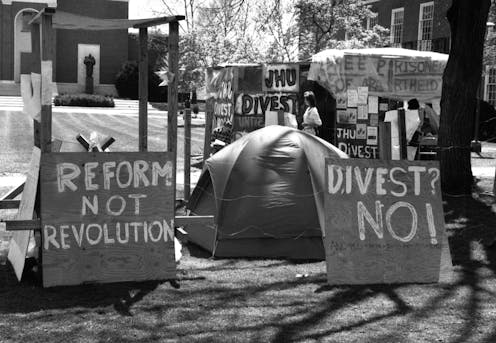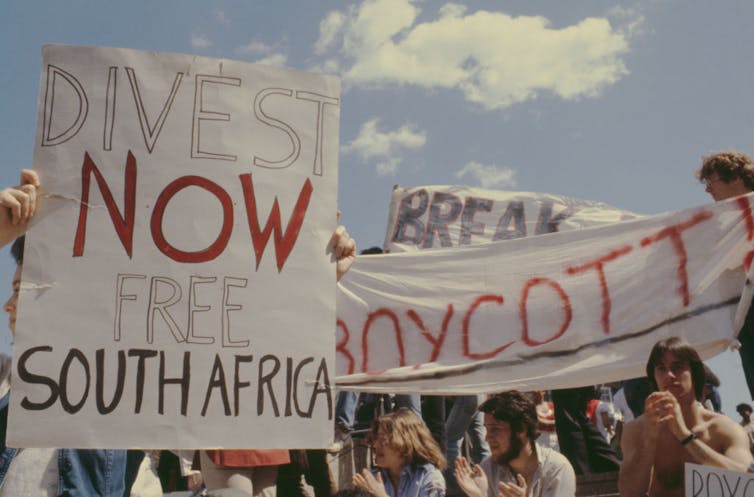Calls for divestment from apartheid South Africa gave today’s pro-Palestinian student activists a bl
In the 1980s, university administrators called the police on anti-apartheid protesters, threatened to revoke their scholarships and ordered staff to demolish encampments.

In recent weeks, college campuses across the U.S. have been roiled by pro-Palestinian protests, with the police called in to arrest demonstrators and students threatened with expulsion.
But there’s nothing unusual about the protesters’ tactics of taking over university buildings and erecting tent encampments on college lawns and quads.
These students, whose actions build on years of organizing spearheaded by the Students for Justice in Palestine, are part of a long history of radical student organizing.
There are echoes of both the protests against the Vietnam War in the 1960s and 1970s and, more recently, of South African apartheid in the 1980s.
In the 1980s, U.S. student activists worked to make higher education “South Africa Free.” They urged institutions of higher learning to commit to divest all assets held in endowments that were tied to doing business in or with South Africa.
Over the past 10 years, I’ve researched and written about these Black-led anti-apartheid movements, with a particular focus on student campaigns.
By calling out complicity on the part of colleges, corporations and the government in South Africa’s system of apartheid, student activists were able to show that demands for divestment could be a concrete and effective form of protest.
A movement decades in the making
Apartheid was a racist and exploitative project that white South African officials had developed over decades.
Segregationist laws and land seizure policies created a captive, impoverished Black population, whose exploitation and disenfranchisement supported the economic prosperity of the governing white minority.
Originally, the idea to push for the sale of assets tied to corporations doing business in South Africa stemmed from the directives of the South African liberation movements, which called for a total economic, cultural and diplomatic boycott of the country’s white minority government.
The foremost South African liberation movements were the African National Congress, formed in 1912, and the Pan Africanist Congress, established in 1959. The South African government banned both organizations in 1960, forcing organizers to build their movements in exile.
In response, anti-apartheid organizers around the world developed creative ways to heed the call.
In the late 1960s, for example, U.S. students targeted U.S. banks that lent to the South African government, calling them “partner[s] in apartheid.”
And the Students for a Democratic Society and the Student Nonviolent Coordinating Committee coordinated a sit-in at Chase Manhattan Bank in New York City in 1965.
Following the 1976 Soweto uprising, in which South African police massacred at least 150 children, some U.S. workers began to demand that their pension funds be “South Africa Free,” and students at U.S. colleges and universities organized some of the first protests calling for the divestment of their schools’ endowments.
The 1977 formation of the Committee to Oppose Bank Loans to South Africa made economic withdrawal a centerpiece of the U.S. anti-apartheid movement, one that grew stronger both on and off campus in the decade that followed.
Calls for divestment grow
At its climax in 1985 and 1986, protests for total economic isolation of South Africa surfaced at more than 200 colleges and universities across the U.S.
Whether they were enrolled at historically Black colleges and universities, liberal arts colleges, Ivy League schools or public universities, students coordinated a national divestment movement, pushing the issue of U.S. investment in South Africa to the center of American intellectual and civic life.
Student organizing formed the militant grassroots basis for the U.S. anti-apartheid movement and contributed to the economic, political and cultural isolation of South Africa’s violent and repressive white minority regime.

Students assembled blockades, organized “sit-outs,” occupied buildings and built “shantytowns” – made to resemble the makeshift dwellings in which many Black South Africans lived under apartheid – at more than 100 universities.
These shantytown protests marked the culmination of nearly a decade of campus anti-apartheid organizing. Thousands of students at hundreds of campuses erected encampments to try to “stop business as usual,” as student groups put it.
Persistence pays off
At schools across the country, university administrators ordered police to dismantle the shantytowns.
University backlash ended up only amplifying support for the movement as media flocked to the shantytowns, while faculty, parents and alumni rallied around the students.
Students, in turn, rebuilt their encampments. Joining them were supporters from beyond the university: musicians, politicians, and New Left and Black Power activists. The presence of feminist political activist Angela Davis, counterculture activist Mario Savio, poet June Jordan, writer Amiri Baraka and Pan-Africanism organizer Kwame Ture helped draw further national attention to student demands.
The highly publicized determination of the students helped turn the tide of public opinion. Founded by Black organizers Randall Robinson, Mary Frances Berry, Eleanor Holmes Norton and Walter Fauntroy, the Free South Africa Movement – working closely with the foreign policy advocacy organization TransAfrica – led hundreds of students and everyday people in a picket outside the South African Embassy in Washington, D.C.
Many of the activists and student protesters were arrested. But by calling out specific corporations doing business in South Africa and popularizing corporate ties to anti-Black violence, oppression and massacres in a foreign country, students succeeded in making investments in those stocks riskier and unattractive.
After two years of sustained militant organizing and demonstrations, the student anti-apartheid movement claimed to have gotten colleges and universities to divest about US$3.6 billion – or $10.3 billion in today’s dollars – from their endowments.
Revisionist history
In 1990, after 27 years of imprisonment, African National Congress leader Nelson Mandela was released from prison.
By then, South Africa’s system of apartheid was crumbling. The reinstatement of the liberation movements in 1990, the repeal of segregationist laws in 1991 and the first democratic election of 1994 signaled the official end of apartheid, though discrimination and inequality persist in South Africa to this day.
In the collective memory of the U.S., anti-Vietnam and anti-apartheid movements are generally seen as righteous struggles that U.S. institutions couldn’t help but get behind.
Perhaps that’s why, after the death of Mandela in 2013, the University of California, Berkeley, administration claimed to be at the forefront of student divestment protests for South Africa.
This was revisionist history.
In fact, at Berkeley and across many campuses, administrators called the police on protesters, threatened to revoke their scholarships, took others to court and ordered custodial staff to demolish the shanties.
Past as present
Activists, scholars and even former U.S. President Jimmy Carter have drawn comparisons between South African apartheid and Israel’s occupation of the Palestinian territories. Many Palestinians refer to the 440-mile (708 km) separation barrier that Israel erected along the Gaza Strip as the “Wall of Apartheid.”
Still, there are some notable differences between the two movements.
Divestment is trickier today because financial instruments are more complex than they were in the 1980s, in part due to the outsourcing of their management to investment firms and hedge funds. The size of many university endowments have also grown exponentially since then.
Nonetheless, I believe divestment from companies doing business with Israel is still possible – and can be an effective demand. Several college administrations have agreed to consider divestment, including Brown University, Northwestern University, Evergreen State College and the University of Minnesota.
The U.S. anti-apartheid movement of the 1980s helped topple South Africa’s apartheid government. Back then, campus anti-apartheid occupations placed students at the forefront of changing the national consensus on U.S. complicity with injustice in South Africa.
Time will tell whether today’s students can do the same with regards to Israel’s systematic oppression of the Palestinian people.
Amanda Joyce Hall has been a recipient of the U.S. Fulbright Student Fellowship Program, The Ford Foundation Fellowship, and the Institute for Citizens and Scholars Newcombe Fellowship.
Read These Next
Who thinks Republicans will suffer in the 2026 midterms? Republican members of Congress
The president’s party almost always loses seats in the midterms. More than two dozen Republican House…
New materials, old physics – the science behind how your winter jacket keeps you warm
Winter jackets may seem simple, but sophisticated engineering allows them to keep body heat locked in,…
Deepfakes leveled up in 2025 – here’s what’s coming next
After a year of fast advances, deepfakes are entering a new era defined by real-time interaction with…






